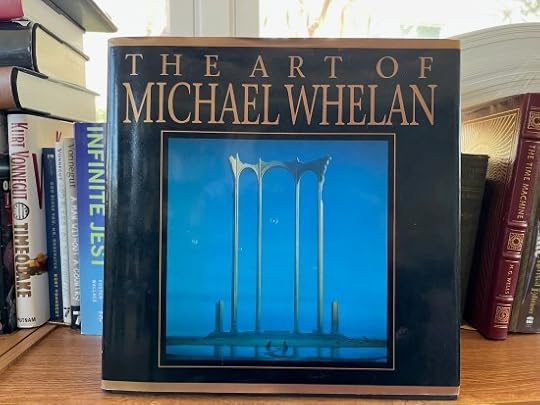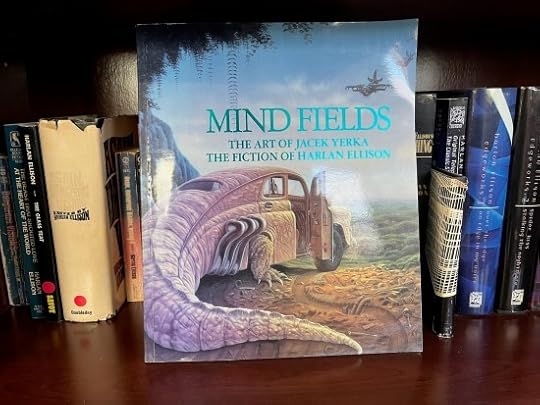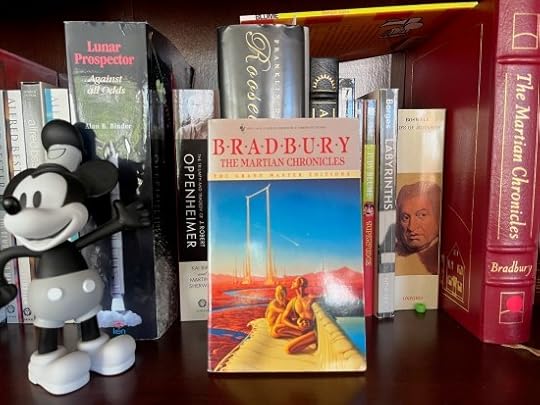Shelf-Life #2: The Art of Michael Whelan

“Books are a uniquely portable magic,” Stephen King wrote. When I was just a youngster, my mom would tell me that books can take you anywhere. Isaac Asimov talked about books being a form of telepathy, a kind of direct communication between the mind of the writer and the mind of the reader. Books can also serve as waypoints to places you can’t possibly imagine. The Art of Michael Whelan is one such waypoint for me.
With the exception of Piers Anthony, I didn’t read a whole lot of science fiction until I was in college, and I didn’t start to broaden my reading of science fiction until my junior and senior years of college. Money was hard to come by in college, and yet, on rare occasions, I would splurge for a book, despite money being tight. One such occasion came in late 1993 or early 1994 when I first saw The Art of Michael Whelan in a bookstore and decided that I had to have it. The book had a cover price of $60 which was more than double the price I’d ever paid for a book before. But I recognized Michael Whelan’s art from the covers of books I’d read, like Piers Anthony’s On a Pale Horse.
To fans of science fiction, Michael Whelan’s name is synonymous with beautiful, stark, alluring pieces of art, most of which appear on the cover of countless books and magazine covers. Cover art was always an afterthought to me—someone who grew up on the adage never to judge a book by its cover—until I encountered the art of Michael Whelan. Michael’s art made me pay attention and demonstrated how a story could create such amazing imagery outside of my own imagination.
I managed to find the $60 plus tax for the beautiful tabletop edition of The Art of Michael Whelan. When I returned to my apartment, I wasn’t quite sure what to do with it. It was, after all, the first art book I’d ever owned, and while there was text in the book, it wasn’t like the books I was used to reading. Ultimately, I found it to be a wonderful break from my studies in the days before the Internet. If I needed a break or distraction from the con-law paper I was writing, I’d pull out The Art of Michael Whelan, sit on the couch, and flip slowly through the pages. The images transported me into Michael’s imagination and for a time, I forgot about my con-law paper. When I was done flipping through the pages, I was ready to get back to work, feeling refreshed.
In high school, I had three years of art history, but nothing made me appreciate art for the pure beauty and joy of it more than Michael’s book. I began to see that great art could tell a story just as well as a novel and I began to seek out more of it. Not long after, I managed to get hold of a copy of Mind Fields: The Art of Jacek Yerka / The Fiction of Harlan Ellison. Here there was a kind of inversion of what Michael Whelan was doing. Whelan took (mostly) novels and provided stunning visual scenes from those words. Harlan Ellison took existing images from Yerka and created stories out of them. Art was dynamic.
 My copy of Mind Fields along with my other Harlan Ellison books.
My copy of Mind Fields along with my other Harlan Ellison books.Michael Whelan’s art opened my eyes to the art of science fiction and fantasy. It helped me identify style in visual arts. It got to the point where I could readily distinguish a piece by Michael Whelan from a piece by, say, Jim Burns. When Harlan Ellison wrote about the art of Leo and Diane Dillon, for instance, I understood that art with a new appreciation that traces back to The Art of Michael Whelan.
Among my all-time favorites is a piece called “Descent,” which I first saw on the Grand Master Edition of The Martian Chronicles by Ray Bradbury. Of course, we all know what Mars looks like today, thanks to the amazing work of scientists and engineers who put robots on the surface of the planet. But how I wish it looked the way Michael Whelan portrays it in his fabulous painting.
 A portion of “Descent” on the cover of the Grand Master edition of The Martian Chronicles.
A portion of “Descent” on the cover of the Grand Master edition of The Martian Chronicles.Whelan’s influence stayed with me. Back when I was writing my series, Vacation in the Golden Age, I tried to focus on the art that appeared in ASTOUNDING in the late 1930s and 1940s. I learned to admire the art of people like Hubert Rogers and Virgil Finlay to name a few. I look through the covers of my ASTOUNDING collection with an interest in the artwork that I might not have had if not for The Art of Michael Whelan.
As I said at the outset, books can become waypoints to places you can’t possibly imagine. When I bought my copy of The Art of Michael Whelan, I was college student who had just started writing and submitting stories for publication, and who had just begun collecting the first of what would become hundreds of rejection-slips. Fast-forward 18 years to the Nebula Award weekend in 2011. By this point, I’d sold several stories, including my first sales to Analog. I had started attending conventions. I had become a member of the Science Fiction Writers of America (now the Science Fiction Writers Association). Kelly was 6 months pregnant with our second child and she accompanied me to the Nebula Award banquet. At our table was none other than Michael Whelan and his wife. Kelly and Michael’s wife seemed to hit it off at once, chatting about kids. I was somewhat speechless at first but finally got up the courage to talk with Michael. It was an entirely surreal experience. Here I was, a kid who had scrounged pennies to buy The Art of Michael Whelanin college, now sitting next to the artist himself. It was something that, when I first bought the book, never entered even my wildest imagination.
I was recently delighted to discovery that Michael Whelan has started a Substack fittingly called The Art of Michael Whelan. He sends out daily art and talks about its creation. I got myself a subscription and look forward to it each day. I recommend it for those who enjoy art of any kind.
Did you enjoy this post?
If so, consider subscribing to the blog using the form below or clicking on the button below to follow the blog. And consider telling a friend about it. Already a reader or subscriber to the blog? Thanks for reading!



